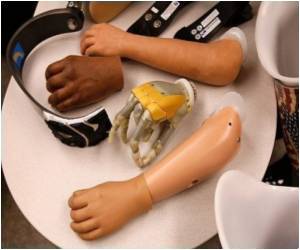Highlights:
- Scientists develop a novel robotic prosthetic arm or LUKE arm that helps amputees control hand movements by thought as well as touch and feel things once again
- The prosthetic arm and fingers are controlled by microelectrodes placed within the person’s muscles. These microwires send impulses to an external computer that interprets these impulses and tells the hand to move
- The robotic arm is also equipped with sensors that transmit signals to the microwires, replicating the feeling of touch when a person holds an object in their hand. Thus, a person can 'feel' the consistency of the object being held so that the right amount of pressure can be applied
The findings of the study appear in the latest edition of the journal Science Robotics.
Read More..
LUKE Arm – Named After Star Wars Character Luke Skywalker
- The developing of the LUKE arm has been underway since 15 years. The arm mostly made of metal motors and components covered by a clear “silicon” hand. It works through an external battery and is attached to a computer. It was created by DEKA Research & Development Corp., a New Hampshire-based company founded by Dean Kamen, inventor of Segway
- During this time, the biomedical engineering department of the University of Utah developed the Utah Slanted Electrode Array which allows the wearer of the prosthetic arm to tap into the nerves of the wearer
- The Array consists of a bunch of 100 microwires placed within the nerves of the amputee’s forearm and attached to an external computer
- The array picks up electrical impulses from the still intact nerves and transmits them to the external computer which in turn converts them to digital signals and instructs the arm to move
- Additionally, the prosthetic arm is also equipped with sensors that transmit signals to the microwire Array, replicating the feeling of touch when a person holds an object in their hand. Thus, a person can 'feel' the consistency of the object being held so that the right amount of pressure can be applied for example without breaking an egg by squeezing too much.
- The manner in which the sensors transmit the signals involves understanding how the brain deals with information when it initially touches an object. Upon initial contact with an external object, a burst of impulses travel rapidly to the brain and then tapers off. This phenomenon had to be recreated which was a major task and achievement
Achieving this involved complex mathematical algorithms and calculations and recording impulses from the arms of primates to recreate a similar model of how touch and feel is interpreted by the human brain. This model was used in the LUKE arm
Story of Keven Walgamott
Keven is one of seven study subjects, who lost part of this left arm and hand to an electrical accident in 2002. There are about 1.6 million amputees in the US, in whom anxiety and depression are common.- After wearing the robotic arm, Walgamott was able to touch and feel objects, identify the size and consistency even while blindfolded and wearing headphones.
- He was able to feel up to 119 different sensations ranging from vibration to pressure.
- He could feel and identify objects accurately and much more quickly than with any other similar system
- He could peel a banana and even send text messages. He could pick up an egg without breaking it by applying too much pressure
Scope of the Study and Future Plans
- The LUKE arm is a boon to amputees who can touch and feel things like normal persons
- Since the prostheses move by the person’s thoughts, it forms a part of a closed system loop and prevents “phantom” pain which amputees feel even though the limb is not there
- A completely portable version that does not need to be wired to an external computer is being developed. All parts will be wirelessly connected making it simpler for the wearer
- Currently, it has been developed to use on below-elbow amputations, but the system can be adapted to above the elbow amputees as well in the future
In summary, the LUKE arm will be a godsend to amputees making them independent and productive and also improves their quality of life by reducing anxiety and depression.
Reference:
- Reach out and touch someone - (https://unews.utah.edu/star-wars-inspired-arm/)
Source-Medindia











